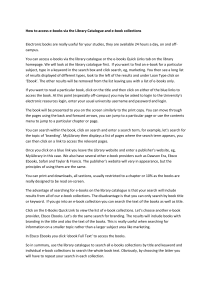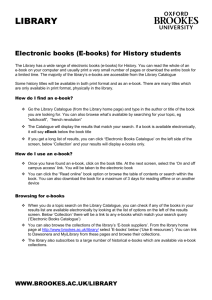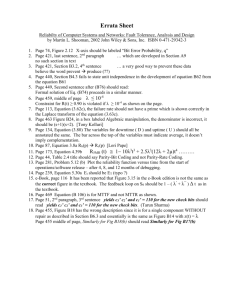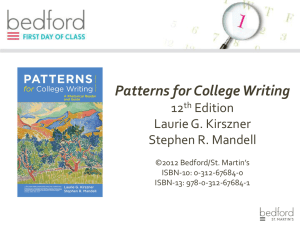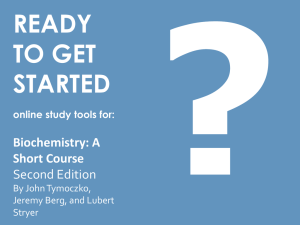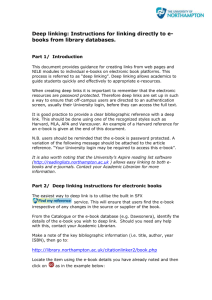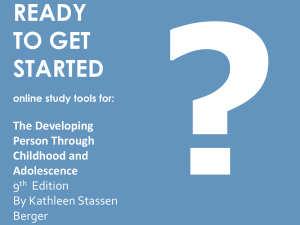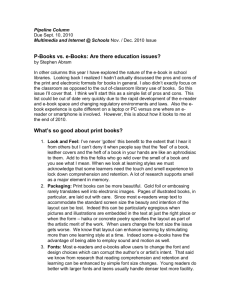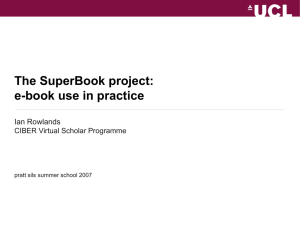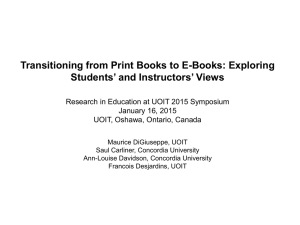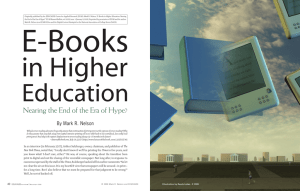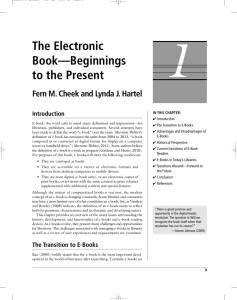Milestone #1 - Stanford HCI
advertisement
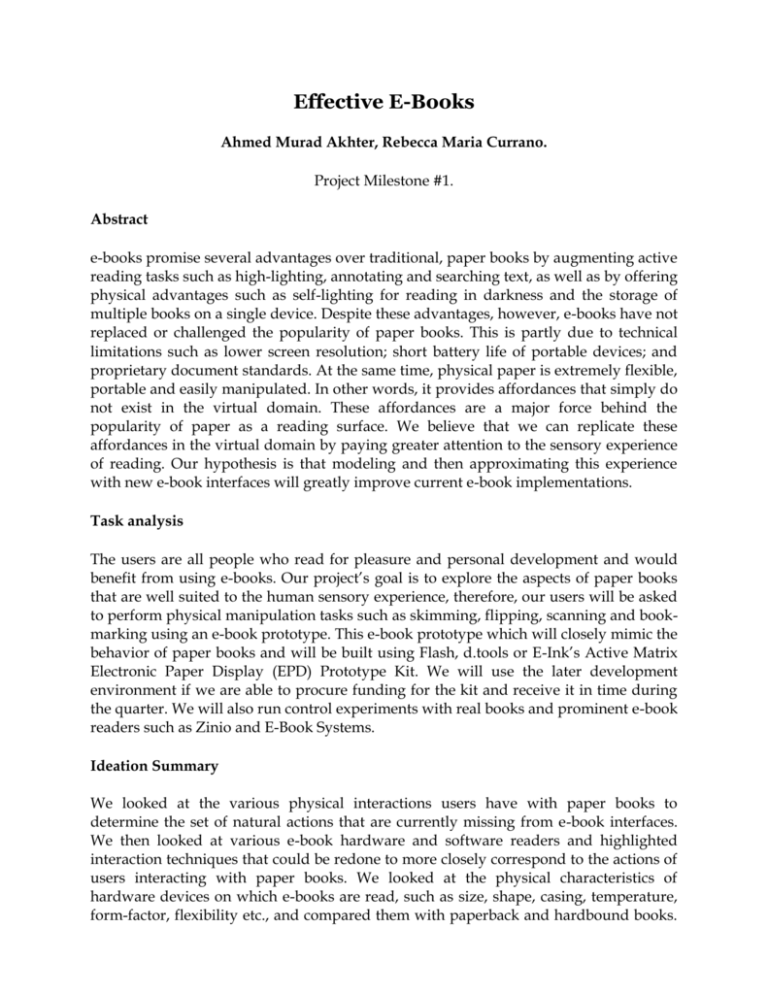
Effective E-Books Ahmed Murad Akhter, Rebecca Maria Currano. Project Milestone #1. Abstract e-books promise several advantages over traditional, paper books by augmenting active reading tasks such as high-lighting, annotating and searching text, as well as by offering physical advantages such as self-lighting for reading in darkness and the storage of multiple books on a single device. Despite these advantages, however, e-books have not replaced or challenged the popularity of paper books. This is partly due to technical limitations such as lower screen resolution; short battery life of portable devices; and proprietary document standards. At the same time, physical paper is extremely flexible, portable and easily manipulated. In other words, it provides affordances that simply do not exist in the virtual domain. These affordances are a major force behind the popularity of paper as a reading surface. We believe that we can replicate these affordances in the virtual domain by paying greater attention to the sensory experience of reading. Our hypothesis is that modeling and then approximating this experience with new e-book interfaces will greatly improve current e-book implementations. Task analysis The users are all people who read for pleasure and personal development and would benefit from using e-books. Our project’s goal is to explore the aspects of paper books that are well suited to the human sensory experience, therefore, our users will be asked to perform physical manipulation tasks such as skimming, flipping, scanning and bookmarking using an e-book prototype. This e-book prototype which will closely mimic the behavior of paper books and will be built using Flash, d.tools or E-Ink’s Active Matrix Electronic Paper Display (EPD) Prototype Kit. We will use the later development environment if we are able to procure funding for the kit and receive it in time during the quarter. We will also run control experiments with real books and prominent e-book readers such as Zinio and E-Book Systems. Ideation Summary We looked at the various physical interactions users have with paper books to determine the set of natural actions that are currently missing from e-book interfaces. We then looked at various e-book hardware and software readers and highlighted interaction techniques that could be redone to more closely correspond to the actions of users interacting with paper books. We looked at the physical characteristics of hardware devices on which e-books are read, such as size, shape, casing, temperature, form-factor, flexibility etc., and compared them with paperback and hardbound books. Our focus was on defining the problem space in relation to the body of the user to describe it in terms of his sensory experience. We, therefore, thought about newer tangible interfaces that could be introduced to make e-book manipulation more intuitive and natural and chose against focusing on technical problems such as screen resolution, battery life, availability of content etc. Our overriding concern was that while these technical issues are active areas of research, e-books ergonomics and human factors research is not. Ideation Results Idea 1: Represent book-marks with physical markers on the e-book, in 3D to show location, relative amount, category etc. Figure 1. Types and purposes of bookmarks Figure 2: Options for viewing and manipulating bookmarks. Idea 2: It’s often possible to tell the contents of the next page when using physical paper, since paper surfaces are not opaque. We could model this with transparency and alpha-blending of pages in e-books to provide a virtual ‘look-ahead’. Figure 3: Translucent mode for ‘look-ahead’. Idea 3: People tend to site, lie down and move about when they’re reading. This requires them to move their books in 3D in order to adjust their viewing angle appropriately. Since displays are not movable we cannot model translations, however, rotations can be trivially supported. Figure 4: Control of orientation for better viewing. Idea 4: Bending a page allows one to quickly scan multiple pages, look at the front and back surfaces of a page and multiple sections of pages together. Figure 5: Flexible pages to enable bending, flipping etc. Idea 5: Folding a page allows a user to ignore irrelevant portions of a page. Figure 6: Folding pages to preserve space. Idea 6: Bending, flipping, stretching and, folding paper is best done by manipulating the flat rectangular surface of a piece of paper. Maybe tangible UI elements can be created to enable this interaction. Figure 7: Tangible interfaces for direct manipulation of e-pages. Idea 7: Page turning transitions provide users intuitive feedback when reading, skimming or going through pages in a book. Figure 8: Page Turning, flipping, skimming etc. Idea 8: Shuffling chapter allows one to easily sort material in a desired order before reading. Figure 9: Shuffling pages to organize and reorder e-books. Idea 9: It’s easier to find information on multiple pages if we can view them all at once. Spreading them out can help accomplish this. Figure 10: Spreading pages apart to see multiple pages together. Idea 10: Cutting a page will let us select, sort and categorize subsets of pages. Figure 11: Cutting / tearing parts of pages. Idea 11: We could improve the reading experience by approximating real-world lighting conditions. Figure 12: simulating natural and indoor light on paper. Idea 12: Represent pages with material properties. Figure 13: Allowing numerous types and textures of paper and mimicking natural properties of these materials such as reflectance and absorption of light. Evidence Most of the evidence in support of our ideas is anecdotal, based upon our own personal observations as well as the considered opinions of our colleagues and friends. A lot of the interactions we identified such as folding, skimming and book-marking pages can be easily observed in any public library or study hall. Reading is a very common activity, therefore, the patterns of manipulation of books are well understood. Further Evidence Our goal is to determine the set of physical interactions that are well suited to the human sensory experience of physical books. For this purpose we will be building a set of simple physical prototypes out of real books in which we restrict one ore more types of interactions. We then wish to determine how exactly we can match this set of interactions with a software prototype, which will be built out of Flash, d.tools or EInk’s EPD Prototype Kit as noted earlier. We will request users to perform physical and cognitive tasks using this prototype, time their responses and compare the results against interactions with physical books. Evaluation Plan We will evaluate the efficacy of various physical interfaces and our effectiveness in translating them to the virtual realm by timing user responses to simple tasks performed with the hardware or software prototypes we will build. Meanwhile, we will ask users to fill out questionnaires and provide feedback on these new interfaces so we can qualitatively determine their impact on user interaction as well. We don’t anticipate that we will need human-subjects approval, however, one team member will be certified to carry out such studies if necessary. Our hope is to get at least 10 users to test our prototypes so we can draw on a broad set of userr tastes and preferences in our evaluations.
